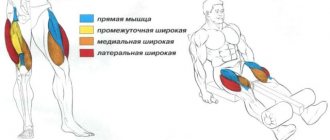What is EMS training
These are workouts that involve applying weak current to the muscles. “During movement or fixing a position during EMS training, electrical stimulation of muscle fibers occurs,” says Ruslan Panov, expert methodologist at X-Fit in Russia. — Current pulses are supplied to the skin by soft electrodes (either directly with suction cups, or through a special fabric suit) and output to a common controller.
The controller is programmed by the trainer via the application. They are also given a simple strength or cardio workout. Thanks to the impulses, the muscle contracts with additional force and expends more energy.” “In such training, a stimulating device is used, which delivers electrical impulses through electrodes attached to the body, thereby causing muscle contraction,” explains Emilia Savelyeva, a massage therapist-rehabilitator with a medical education, author of the “Online Anatomy” course for body specialists. - Plus, you perform exercises and thus the force of muscle contraction increases. The impulses cause 90% of muscle tissue to contract, including hard-to-reach areas.”
Initially, EMS training was used only for rehabilitation purposes - to strengthen muscles and restore patients with serious injuries to the musculoskeletal system, etc. Later, myostimulation technology “migrated” to the field of fitness, but there is still a health aspect in EMS training.
The effect of EMS training on weight loss
Let's look at another study. Electromyostimulation of the whole body as a means of influencing muscle mass and abdominal fat in elderly women.
The aim of the study was to determine the effect of whole body electrical stimulation on muscle mass and appendiceal abdominal mass in individuals particularly at risk for sarcopenia and abdominal obesity but unable or unwilling to exercise.
Studies have shown a decrease in fat, although slight, but contractility in the leg extensors was significantly improved. This led to the conclusion that such methods have a positive effect not only on adipose tissue, but on the functions of skeletal muscles. Therefore, such training is a good alternative for those who do not want to move or put in effort at all.
Source link: https://www.ncbi.nlm.nih.gov/pmc/articles/PMC3795534/
How EMS training works
EMS fitness classes are usually held using special suits. “You put on a wetted suit with built-in electrodes,” explains Irina Mantrova, personal trainer, founder of the EMC fitness studio Gymruhs . “A medium-frequency current is supplied through a special wire, which causes irritation of the working organ or muscle group, contraction and response of the body.”
If you “came” to classes for a beautiful figure and toned muscles (and not for the improvement of internal organs or massage, which is also possible with EMS devices), you will have to perform cardio or strength exercises in the suit. Ideally, the first classes should be simple, so that the body adapts to this type of impact on the muscles, and you master the technique of performing the exercises. “Some trainers on a guest visit, in order to win over a client, put a suit on a newcomer and force him to do push-ups and squats without first setting up the technique. This can lead to overtraining and injury,” warns Irina Mantrova. If you notice this, ask your trainer to reduce the load.
The average training duration is 30 minutes.
How it works?
During training, you wear a special suit with built-in electrodes and perform strength and cardio exercises. Dr. Khaikin explains how training with electrical stimulation differs from regular training: “During standard training, muscle contractions occur due to electrical impulses coming from the brain. And if you add additional stimulation to this, the muscles will begin to contract more strongly and deeper muscle layers will be involved in the work.”
Therefore, the sensations during EMS training are quite strange - the muscles seem to live their own lives and contract not because you, for example, squat, but because of external stimulation that the brain does not control.
Is EMS training safe?
“Won’t it give me an electric shock?” — a common question from clients during their first ems fitness sessions. We answer with the experts: no. Firstly, this excludes the design of the suit. Secondly, ems fitness classes are always supervised by a trainer, who, as a rule, clearly controls the number and strength of impulses.
However, if you have a pacemaker, these activities are contraindicated.
There are no special restrictions on ems fitness for teenagers. “I would recommend EMS only as a way to establish high-quality exercise technique and use low impulse intensity,” notes Ruslan Panov. “From a safety point of view: in adolescence it is already possible to use the technology (in medicine it is even used in working with children with cerebral palsy), but without a general effect, but locally on the muscles involved in the exercises.”
Who is not suitable for EMS training?
- If you are not ready to spend a significant amount. EMS training will cost you a little more than visiting a regular gym.
- If you don't want to stress and expect no stress. EMS training is often called “fitness for the lazy,” but this is not true. External impulses will make your muscles (including small and deep ones) literally tremble, so performing even the most basic exercises will not seem so easy to you.
- If you are a follower of classical training and trust only the weight of the barbell. Some people may enjoy the very process of regular exercise in the gym, but electrical stimulation, on the contrary, may cause discomfort. Exercising in wet uniforms and a tight vest is also not the most pleasant feeling.
Contraindications
Low-frequency stimulation does not harm health; the restrictions are the same as for normal physical activity. Among the categorical contraindications is only a prosthesis in the heart. If you have cardiac disease or have a pacemaker installed, be sure to consult your doctor.
It is better to refrain from EMS training for pregnant women, since to date there has been no research in this area, but after the birth of a child it is an excellent way to quickly restore the pelvic muscles.
What do you think about the future of fitness? Write in the comments.
Efficiency
With a properly designed training program and regular training, ems fitness is quite effective. “If you correctly select programs for the client’s specific tasks, you can work out the whole body in 20-30 minutes,” explains Irina Mantrova.
Depending on the type of device (at what frequencies it operates: low, medium, high), EMS training can affect only the muscular corset or also the internal organs. “With high- and medium-frequency devices, it is also possible to influence the endocrine system (establish hormonal levels), stop pathological processes of the thyroid gland, pancreas, genitourinary system (prostatitis), block fibroids, endometriosis - these are all indications for EMS training,” - adds Irina Mantrova.
EMS training also helps to achieve some fitness goals - lose weight, tighten your silhouette. “The results from EMC will be rapid and more lasting compared to regular fitness. The quality of the muscle fiber, the relief is more obvious, the skin turgor is better. The skin is smoothed out,” says Irina Mantrova.
But EMS training will not help in the fight against cellulite.
“Electrical impulses will improve blood and lymph circulation, but will not solve the problem with skin lumpyness,” adds Emilia Savelyeva.
EMS training for restorative and therapeutic purposes
For more than 50 years, electromyostimulation has been used in physiotherapeutic practice as a method of muscle recovery after injuries and operations. In the 1960s, EMS was often used to prevent atrophy that occurs when skeletal muscle denervation occurs. With the development of technology, its use to treat patients with central nervous system damage caused by brain damage has become increasingly popular. In the 1980s, scientists developed devices capable of generating electrical waves of different shapes, which were used to restore patients who had undergone orthopedic surgery. EMS has been clinically proven to alleviate muscle wasting and, as a result, has a positive effect on the cancellous bones of the human skeleton. A detailed study is available on the website of the US National Library of Medicine.
The metaphyseal and epiphyseal trabecular regions of the distal femur were analyzed using microcomputed tomography and histomorphometry. The figure shows the state of the bone in the complete absence of muscle activity of the department (HLS) and subsequent states when stimulation is applied to the muscles (without any other load) at 1 Hz, 20 Hz, 50 Hz, 100 Hz, respectively. Myostimulation with a frequency of 50 Hz demonstrated a significant preventive effect in all respects. Dynamic muscle stimulation with a specific schedule may be useful in counteracting osteopenia and osteoporosis.
EMS strengthens joints and reduces the risk of injury due to the fact that exercises are performed without weights, and at the molecular level it improves anabolic and catabolic processes and stimulates the regenerative ability of satellite cells. Scientific studies show that the technology is great for people who have problems with the lower back, knees, shoulders, etc. EMS is sometimes used for quick and active recovery after serious exertion, for example during a break in the game. This became possible due to the fact that electrical stimulation improves blood circulation and, as a result, accelerates the removal of lactate (a breakdown product of lactic acid) and various metabolites from the blood. Compared to other rehabilitation methods, this one is as simple as possible to use and is suitable for people who cannot or do not want to use other rehabilitation measures.
EMS training: advantages and disadvantages
The main advantage of EMS training is that it is available even to those who have serious health problems and are prohibited from classical sports. “EMS fitness allows for rehabilitation and recovery in post-operative processes. If there are hernias, protrusions, then with these trainings we relieve radicular syndrome, pain in the back, buttocks, legs, etc., notes Irina Mantrova. - We also exclude various types of injuries - sprains, microtraumas of muscles. We not only work on the muscular corset, but also improve the overall health and well-being of a person.”
How effective are EMS trainings in terms of developing strength, endurance and muscle definition? There is no consensus here. “In the medical field, myostimulation works wonders even in almost hopeless cases; in the fitness industry, the method is a niche offshoot of technologically innovative training. You shouldn’t consider them as a full-fledged opportunity to improve your body, although after the first ems training the results can be simply stunning. This is due to stress in the body from unusual activity,” says Ruslan Panov.
Some experts believe that building muscle will also be more difficult with EMS training than with classic strength training. “For development, a muscle must work fully, throughout the entire length of movement. And myostimulation gives an impulse only to the area to which the electrode is connected, notes Ruslan Panov. “In addition, electromyostimulation has a local effect, and modern science suggests that it is necessary to create chains of balanced movements that involve as many body segments as possible.”
There are also some situations when ems fitness classes are completely powerless.
The benefits of training
The main problem with intense strength and high-impact training is the risk of joint damage. Healthy young people with good athletic training can tolerate moderate exercise without much trouble. However, too active activities, age, hidden injuries or congenital pathologies can cause unpleasant consequences. Deep squats, numerous push-ups, exercises with free weights, and abdominal swings strengthen the muscle corset, but can provoke inflammation of the knee or elbow joints, the development of a spinal hernia, osteochondrosis or osteoarthritis.
The EMS technique involves the development of deep muscles that support the spine, abdominals, shoulders and hips. When contracting, the joints do not experience stress, and the risk of overexertion and accidental injury is minimized. The technique is especially recommended for:
- insufficient physical training;
- problems of the musculoskeletal system;
- weak muscles and joints;
- a large amount of visceral fat that needs to be gotten rid of.
The technique allows you to cope with local fat deposits that are difficult to respond to regular exercises. It actively develops internal muscles, improves endurance, allowing you to gradually increase loads and avoid injuries.
Don't count on instant results. A positive result can be achieved after several weeks of training, which should take place under the close supervision of a trainer. Real EMC simulators have nothing in common with the products that TV stores persistently advertise. “Magic belts”, butterfly overlays and other dubious devices will not provide a load on the muscles, moreover, all these devices are fragile, fragile and unreliable. You can achieve success only in proven centers, opened as franchises or created by enthusiastic trainers. Classes in small groups are most effective, and it is better for beginners to train separately from advanced users.
For training, you need special suits made of thick rubberized fabric.
In what cases EMS training will not help you?
If you don't follow your diet
Here the situation is the same as with any other training. If you do ems fitness to lose weight, but eat without denying yourself anything, you shouldn’t expect a miracle. “If you attend EMC training and eat for three, eat fatty, sweet, fried foods, you don’t need to expect any results,” says Irina Mantrova.
If you ignore all other activities
For the health of the musculoskeletal system and the harmonious development of the silhouette, it is important not to focus on just one type of fitness. This is especially true for those who would like to lose weight. “You can lose weight well with ems training if you supplement it with strength and functional fitness classes,” says Ruslan Panov. — As a method that gives the body the necessary shake-up and boosts metabolism, EMS fitness is wonderful. As the main type of exercise, it is still not very effective, except for the first two to three months, when the body is not yet accustomed to it and spends more energy. To burn fat you need different types of fitness.”
It is optimal to do EMS training twice a week and add cardio and interval training 1-2 times a week.
For medical contraindications
Although EMS fitness is generally safe, some diagnoses still rule out “electrical training.” “EMS is not suitable for people with problems of the cardiovascular system, since the passing current can disrupt the rhythm of heart contractions, causing damage to the general blood flow and heart muscle tissue,” notes Ruslan Panov. “Also, people with diabetes should not attend ems training; due to incorrectly functioning receptors, their sensations are dulled, and training can put a lot of stress on the body, for which the body is not yet ready.”
Ems fitness is also prohibited for pregnant women. “Pregnant women should never attend EMC training. Electrical impulses create additional muscle tension in the pelvic area and abdominal cavity, which can lead to an increase in the tone of the uterus,” adds Emilia Savelyeva.
It is better for them to choose bodyweight classes and simple yoga.
Experts advise seeing a doctor before starting such classes. “Before you sign up for EMC, undergo a medical examination to make sure you are healthy,” reminds Irina Mantrova. “There are known cases where, after a few months of training, an unexamined client developed serious health problems.”
But if there are definitely no contraindications, these problems should not arise.
If you need serious muscle growth
Do you dream of biceps like Schwarzenegger? Alas, ems training alone cannot “sculpt” an athlete’s figure. “With the help of electromyostimulation, it will not be possible to gain muscle mass, since for this there is no main condition - overcoming gravity with increased muscle effort. This requires critical weights, since the muscle fiber must be injured to increase volume, resulting in the growth of new, strengthening muscle tissue. Loading the muscles with electrical impulses is not enough to solve this problem,” warns Ruslan Panov.
Follow these guidelines to achieve the best results with EMS training.
Conclusions on the Effective Use of EMS Training
The main conclusion that can be drawn by summarizing the results of the above studies is that
EMS exercises are most effective when combined with specialized sports training . Moreover, in most experiments, electrical myostimulation took up only about 10% of the time of the main training. It is also important that positive dynamics of indicators were recorded among both professional athletes and amateurs, which indicates the high effectiveness of EMS training, regardless of the level of training.
Coach Suleymanov Iles Bekkhanovich.
Master of Sports of Russia, 3rd dan black belt, member of the Russian national team, winner of the Russian Championship, prize-winner of the European Championship. Founder and director of the Kudo club “GRIZZLY FIGHT CLUB”. In most studies, to obtain valid results, not only an experimental group, but also a control group took part, consisting of athletes of the same qualifications (often even from the same team), who were engaged in an identical training program, but did not use EMS equipment. In a relatively short period of time (from one to six weeks), representatives of the experimental groups increased muscle strength by 10–50% and, as a result, improved a number of key skills for their sport. Such progress can be regarded as an exceptional result, since it takes incomparably more time to achieve similar results using only traditional training. Many athletes may be interested in incorporating EMS training into their program to periodize their training process. For example, thanks to electromyostimulation, you can increase the intensity of your training and thereby develop your aerobic endurance by loading your body for a short period of time with the same exercises (say, boxing) that you can do for hours without feeling tired without EMS equipment.
Anecdotal evidence of the effectiveness of EMS training
The studies discussed above are only part of the publicly available scientific experiments confirming the effectiveness of the use of electromyostimulation in sports. In addition to scientific information, the effectiveness of EMS is supported by the opinions of many coaches, athletes, physical therapists, etc., based on their personal experiences and the experiences of those with whom they work. Of course, these opinions cannot be considered scientifically proven facts, however, it is worth noting that representatives of such sports as rowing, kayaking and canoeing, swimming, gymnastics, etc., both athletes and coaches, have repeatedly stated that in their practice, the integration of EMS technology into the training process had a positive effect on both overall endurance and short-term peak values of muscle contraction strength. Due to the fact that a healthy lifestyle is gradually turning from a trend into a lifestyle, the popularity of certain segments of the fitness and beauty industry, including electromyostimulation, is growing. As a result, more and more documented studies are emerging confirming the effectiveness of EMS in combination with various physical activities and a positive effect on skin condition, blood circulation, lymph flow and other internal processes. This opens up new opportunities for the development of both the physical qualities of individuals and the EMS industry as a whole.
When writing this article, the following sources were used: Official Journal of the Society for Behavioral and Cognitive Neuroscience (scientific portal supported by the American Academy of Neurology); US National Center for Biotechnology Information; Washington University School of Medicine, USA; Laboratory of Physiological Adaptation, University of Poitiers, France.; Faculty of Sports Sciences, University of Burgundy, Dijon, France; Institute of Research and Innovation in Biomedical Sciences of the Province of Cadiz (INiBICA), Cadiz, Spain; Royal Spanish Athletics Federation, Spain; Department of Health Sciences, University of Jaen, Spain; Laboratory of Neuromuscular Research, Schulthess Clinic, Zurich, Switzerland; Department of Physical Education and Sports, University of Seville, Seville, Spain; Laboratory of Physiology, PPEH, Saint-Etienne, France; Department of Orthopedic Surgery, Physical Medicine and Rehabilitation, Ludwig Maximilian University of Munich, Munich, Germany; Department of Physical Education and Sports, University of Las Palmas de Gran Canarias, Las Palmas, Spain; Department of Exercise Science, University of Milan, Italy; Department of Kinesiology and Sport Management, Texas Tech University, Lubbock, TX, USA; Department of Psychology, Northern Michigan University Marquette, Michigan; Department of Traumatology and Orthopedic Surgery, HU Virgen del Rocío, Seville, Spain; Laboratory of Biomechanics, Department of Physical Education, Aristotle University of Thessaloniki, Hellas, Greece; Department of Biomedical Engineering, Stony Brook University, New York, USA;
Books: Issurin V.B. Training of athletes of the 21st century: scientific foundations and construction of training. - M.: Sport, 2021. Nikolaev A.A. Electrical stimulation in sports
© emsnoble.ru, 2021. All rights reserved. Full or partial use of the article is possible only with a link to
The situation on the EMS training market and development prospects in Russia
Despite the fact that this is the fastest growing fitness segment in Germany and the UK (leaders in the European fitness market), in Russia everything is just beginning. EMS equipment is present in sports clubs, boarding houses and training bases, but you can find an EMS studio or find such a service in a beauty salon mainly in large cities, and even then not in all.
This is largely due to two factors. • The average training price ranges from 1,200 to 3,500 rubles, depending on the location and infrastructure. For large cities, this is comparable to the cost of a lesson with a personal trainer in a fitness room, but not everyone can afford it. • Often, entrepreneurs - out of ignorance or trying to sell a service at all costs - form unrealistic expectations among clients: that EMS will do everything for you, that you will lose X kilograms in X amount of time, that you won’t have to strain, etc. Everything the above has nothing to do with reality. Firstly, EMS training is high-intensity: in 25 minutes, muscle groups are fully loaded. And secondly, no one has canceled the integrated approach, because, as with any other training, lifestyle, namely nutrition and rest, is crucial. Consequently, entrepreneurs who create false expectations among customers not only damage their own reputation and destroy their business, but also harm the EMS industry as a whole.
Despite these factors, the number of people who have seen and appreciated the benefits of EMS training is growing exponentially, as evidenced by both the statistics of requests on the Internet and the number of new studios and the development of networks. This is also due to the growing demand for personalized services in recent years and the number of studies confirming the effectiveness of the technology over and over again. Therefore, the day is not far off when every district of every city will have its own EMS studio and will be available to absolutely everyone, regardless of goals and income level.
© emsnoble.ru, 2021. All rights reserved. Full or partial use of the article is possible only with a link to











